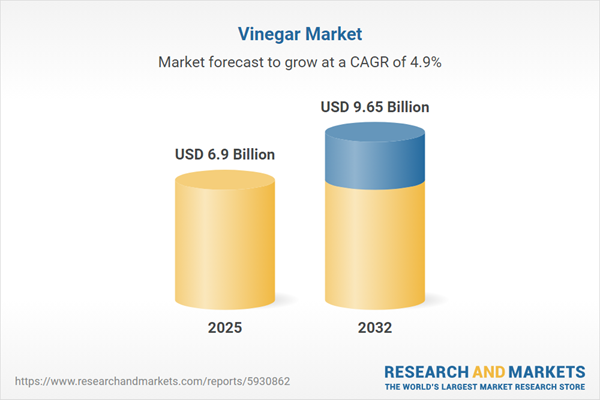Speak directly to the analyst to clarify any post sales queries you may have.
The vinegar market is rapidly evolving, fueled by shifts in consumer wellness priorities, digital transformation, and sustainability strategies. Leaders across the value chain are reevaluating their positions as new opportunities emerge and global dynamics introduce both challenges and avenues for competitive advancement.
Market Snapshot: Global Vinegar Market Growth Trajectory
The vinegar market grew from USD 6.59 billion in 2024 to USD 6.90 billion in 2025. It is expected to continue growing at a CAGR of 4.86%, reaching USD 9.65 billion by 2032. This growth is underpinned by rising consumer demand for natural, functional products, diversified applications in health, cleaning, and agriculture, and increased global accessibility through enhanced e-commerce and supply chains.
Scope & Segmentation: Broad Coverage for Strategic Decision-Making
This comprehensive report explores the global vinegar market landscape, capturing its diverse segments and regions. Major segmentation categories include:
- Type: Apple Cider Vinegar, Balsamic Vinegar, Buffered Vinegar, Red Wine Vinegar, Rice Vinegar, White Vinegar
- Source: Natural, Synthetic
- Product Form: Capsules & Supplements, Liquid, Powder
- Grade: Food Grade, Industrial Grade
- Application: Agriculture, Cleaning & Hygiene, Food Preparation (Cooking & Baking, Dressings & Marinades, Pickling), Healthcare
- Distribution Channel: Offline Retail (Convenience Stores, Supermarkets & Hypermarkets), Online Retail (Brand Platforms, eCommerce Platforms)
- Regions: Americas (North America: United States, Canada, Mexico; Latin America: Brazil, Argentina, Chile, Colombia, Peru), Europe, Middle East & Africa (Europe: United Kingdom, Germany, France, Russia, Italy, Spain, Netherlands, Sweden, Poland, Switzerland; Middle East: United Arab Emirates, Saudi Arabia, Qatar, Turkey, Israel; Africa: South Africa, Nigeria, Egypt, Kenya), Asia-Pacific (China, India, Japan, Australia, South Korea, Indonesia, Thailand, Malaysia, Singapore, Taiwan)
- Key Companies Analyzed: Acetificio Andrea Milano s.r.l., American Garden, Associated British Foods PLC, Bragg Live Food Products, LLC, Brightland Inc., Carl Kühne KG, Castelo Alimentos S/A, Classic Wine vinegar, Dalian Tianpeng Food Co., Ltd., De Nigris Group, Eden Foods, Inc., G. Bruce & Company Limited, Kerry Group PLC, Kimberley Wine Vinegars, Kosterina Corporation, Laconiko, Manor Vinegar, President Kikkoman Zhenji Foods Co., Ltd., Reinhart Foods Limited, Sane Shell Carbon Pvt Ltd, The Kraft Heinz Company, The MadHouse Vinegar Co., The Slow Vinegar Company
Key Takeaways: Strategic Insights for Senior Decision-Makers
- Consumer preferences are shifting toward natural ingredients and wellness-oriented functionality, driving innovation in both health-focused formulations and traditional culinary uses.
- Digital transformation—via online retail and personalized engagement—enables niche and emerging brands to compete globally, leveling the competitive playing field.
- Sustainability imperatives are influencing every aspect of the value chain, from regenerative sourcing and renewable packaging to eco-friendly production processes.
- Manufacturers are responding to regulatory changes and quality expectations by refining standards, enhancing traceability, and achieving industry-relevant certifications.
- The integration of new technologies, such as advanced fermentation and extraction, supports operational efficiency and expands the scope of possible product innovation.
- Close collaboration across the supply chain—linking growers, logistics providers, and research institutions—improves agility in adapting to disruption and capitalizing on new market dynamics.
Tariff Impact: Navigating Trade Disruption in the United States
The adjustment of United States tariffs in 2025 has introduced new complexity into vinegar trade and production. Domestic producers are scaling up in response to higher import duties, while supply chain strategies and procurement practices are being recalibrated to secure resilience and ensure compliance. Exporters are investing in certifications and logistics infrastructure to meet evolving requirements in the U.S. market, while manufacturers shift toward value-added product propositions to offset increased input costs and sustain market relevance.
Methodology & Data Sources
This analysis uses a robust, multi-layered methodology: structured primary interviews with senior executives, qualitative surveys spanning procurement, culinary, and wellness sectors, and comprehensive secondary analysis involving industry reports, regulatory documents, academic publications, and competitive benchmarking. Data triangulation validates trends and cross-checks insights for maximum reliability.
Why This Report Matters
- Empower confident strategy development by pinpointing high-growth segments and innovation drivers.
- Benchmark organizational approaches against top industry players and adapt to global regulatory frameworks.
- Gain clarity on the effect of supply chain shifts, sustainability practices, and digital advancement on future competitiveness.
Conclusion
This vinegar market report equips leaders with evidence-based insight, actionable strategies, and a forward-looking perspective—supporting informed investment, product development, and market entry decisions in a complex global environment.
Additional Product Information:
- Purchase of this report includes 1 year online access with quarterly updates.
- This report can be updated on request. Please contact our Customer Experience team using the Ask a Question widget on our website.
Table of Contents
3. Executive Summary
4. Market Overview
7. Cumulative Impact of Artificial Intelligence 2025
Companies Mentioned
The companies profiled in this Vinegar market report include:- Acetificio Andrea Milano s.r.l.
- American Garden
- Associated British Foods PLC
- Bragg Live Food Products, LLC
- Brightland Inc.
- Carl Kühne KG
- Castelo Alimentos S/A
- Classic Wine vinegar
- Dalian Tianpeng Food Co., Ltd.
- De Nigris Group
- Eden Foods, Inc.
- G. Bruce & Company Limited
- Kerry Group PLC
- Kimberley Wine Vinegars
- Kosterina Corporation
- Laconiko
- Manor Vinegar
- President Kikkoman Zhenji Foods Co., Ltd.
- Reinhart Foods Limited
- Sane Shell Carbon Pvt Ltd
- The Kraft Heinz Company
- The MadHouse Vinegar Co.
- The Slow Vinegar Company
Table Information
| Report Attribute | Details |
|---|---|
| No. of Pages | 194 |
| Published | November 2025 |
| Forecast Period | 2025 - 2032 |
| Estimated Market Value ( USD | $ 6.9 Billion |
| Forecasted Market Value ( USD | $ 9.65 Billion |
| Compound Annual Growth Rate | 4.8% |
| Regions Covered | Global |
| No. of Companies Mentioned | 24 |









